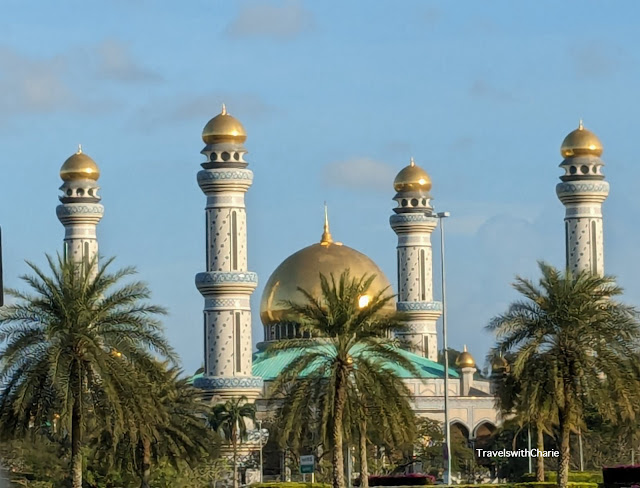Jame’Asr Hassanil Bolkiah Mosque
One of the most picturesque mosques I’ve visited. It’s even more attractive to view at sunset when the gold domes reflect the sunlight. And it is surrounded by beautiful gardens with fountains that cool and calm the senses.
Language and Literature Bureau
The history of Brunei spread out across a 30 meter wall. Created from mosaic tiles after a painting by a local artist, it was completed in 1965 and portrays the people of Brunei performing everyday tasks related to its economy. Though Brunei is a small country with less than half a million inhabitants, it has a robust economy driven by oil and natural gas. Its citizens enjoy free education and health care.
Sultan Omar Ali Saifuddien (SOAS) Mosque
The SOAS mosque is one of two masjid negara or national mosques in Brunei. It is named after the 28th Sultan of Brunei hence it is sometimes called SOAS 28 Mosque. The large central dome is made of real gold. The mosque is also known as the Taj Mahal of Brunei with Mughal architectural influences throughout the structure.
The interior blends Islamic and Italian design elements. The carpets were hand made in Belgium and Saudi Arabia, the chandeliers were manufactured in Great Britain, the marble columns and floors are Italian. Note the escalator leading to the minbar (pulpit) in the background.
This is a replica of the ship of Sultan Bolkiah who reigned in the 16th century. It sits on the lagoon surrounding the SOAS mosque. It is used for national Islamic events.
Kampong Ayer (Water Village)
This is the largest water settlement in the world. It is connected by 30km of wooden walkways and is a self contained community with its own mosques, schools, stores, fire and police stations, etc. Dubbed as the Venice of the East, it has existed for more than 600 years. Definitely take a small boat to explore the 40 villages on stilts along the banks of the Brunei River. For more images and information about Kampong Ayer, please check my post about it here: https://www.travelswithcharie.com/2024/09/cruising-around-kampong-ayer-water.html and my video here: https://youtu.be/0NhbtIfmku4?feature=shared
Ripas Bridge
Ripas or Queen’s Bridge connects the city center and Sungai Kebun. This cable stayed bridge is name after the Queen Saleha, the Queen consort of the current Sultan of Brunei. It’s tower is 157 meters high (515 ft.) and is crowned by an Islamic dome.
Gadong Night Market
This is the best night market we visited. There were many food choices. We ended up buying a whole fish and rice which we ate at our hotel. The market is clean with tables for dining if you would prefer to eat here. Check out my article about Gadong market and its food offerings here: https://www.travelswithcharie.com/2024/04/gadong-night-market.html
Teng Yun Taoist Temple
The majority of worshippers at Teng Yun are from the Chinese community of Brunei. There are approximately 30,000 Chinese in Brunei and they form 10% of the population. This temple was built in the 60s.
The Mall Gadong
This mall has a big food court and theaters if you’re not interested in shopping.
Rizqun International Hotel Lobby
Connected to the Gadong Mall, the Rizqun has a beautiful Art Deco lobby.
Radisson Hotel
2203 Jin Tasek, Bandar Seri Begawan
This hotel is conveniently located across from a night market and the Royal Regalia Museum.
Where to eat:
Gadong Market
The selection of dishes prepared here are more than enough to satisfy the finicky eater. Ok they have hot dogs on a stick too.
Tasek Brasserie at the Radisson Hotel
I ate here twice as I liked the grilled sea bass served with anchovy crackers and pumpkin gulay. It was very good. I particularly liked the crackers sprinkled with dried anchovies.
Grilled sea bass
How to get around:
Don’t hesitate to take a taxi because the price of gasoline in Brunei is quite cheap and getting around by taxi won’t break the bank. There is no Uber in Brunei but there is Dart. You can ask the hotel staff to get a Dart car for you or download their app.
Currency:
Brunei Dollar (BND). USD$1.00 = 1.36BND at today’s rate.
Local Guide:
IG: Alohazizan
Phone: 6737316880
Azizan is well educated, speaks fluent English, enjoys interacting with visitors who can learn a lot from his narratives about the country’s political and cultural history.
Where to shop:
Yayasan Komplex across from the SOAS mosque. I bought some fabrics (including batik) and scarves at Nazmi Trading located on the first floor. The prices were quite reasonable and the salespeople were friendly and attentive.
*****
Images by TravelswithCharie














